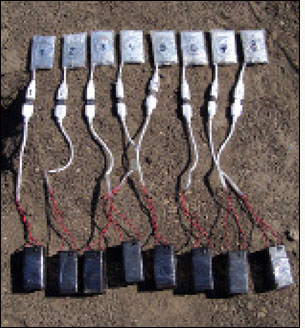Since humans began farming more than 10,000 years ago, they have relied largely on their own senses to determine how much water crops need. But as water becomes scarcer, farmers have a greater need to determine precisely how much water specific crops require. Radio frequency sensors could help solve this problem.
Mehmet Can Vuran, an assistant professor at the University of Nebraska-Lincoln, is leading a team of researchers to develop what could be the world’s first underground RF sensor networks. The idea is to embed wireless sensors that monitor soil condition underground and then transmit the data from one sensor node to another, and finally to either a farmer’s handheld computer, a fixed base station or an irrigation system. The data would enable farmers to determine the amount of water the soil needs.

“Research shows that you can produce the same amount of crop with 25 percent less water,” Vuran says. “That would save farmers a lot of money on irrigation.”
Some Nebraskan farmers have been using underground sensors that have a wired connection to an aboveground data logger. Most of these data loggers must be read manually or with a short-range RF device. That creates two problems. Farmers must invest more time and labor to collect and analyze the data before they can use it, and ploughs must maneuver around the loggers to avoid damaging them.
Vuran and his team recently won a National Science Foundation CAREER grant to marry the soil sensors with underground RF communications networks, so sensors can be buried deep enough to avoid ploughs and data can be collected automatically.
Vuran acknowledges they still have a long row to hoe. RF energy is absorbed by water at higher frequencies, so the signals from RF sensors using conventional communication protocols don’t travel far through soil. Even a 5 percent increase in soil moisture leads to a significant decrease in signal strength, he says. This means with current techniques, sensors would have to be placed very close together to create an ad hoc mesh network, adding to the cost of the system.
Vuran estimates it will take five years or more to create a viable product. He and his team are designing new types of antennas that can send signals through soil. They’re also developing new modulation techniques to increase the range of subterranean RF sensors. And they’re creating system designs that could allow pivot irrigation equipment to communicate with underground sensors as it moves across a field.
“We have created a large-scale test bed at the University’s South Central Agricultural Laboratory,” Vuran says. “We’ve deployed underground sensors and done some experiments communicating with center pivot irrigation systems. We have some antennas that can communicate from 25 meters to 30 meters, from aboveground to underground. We still have a lot of work to do before the technology can be commercialized.”

